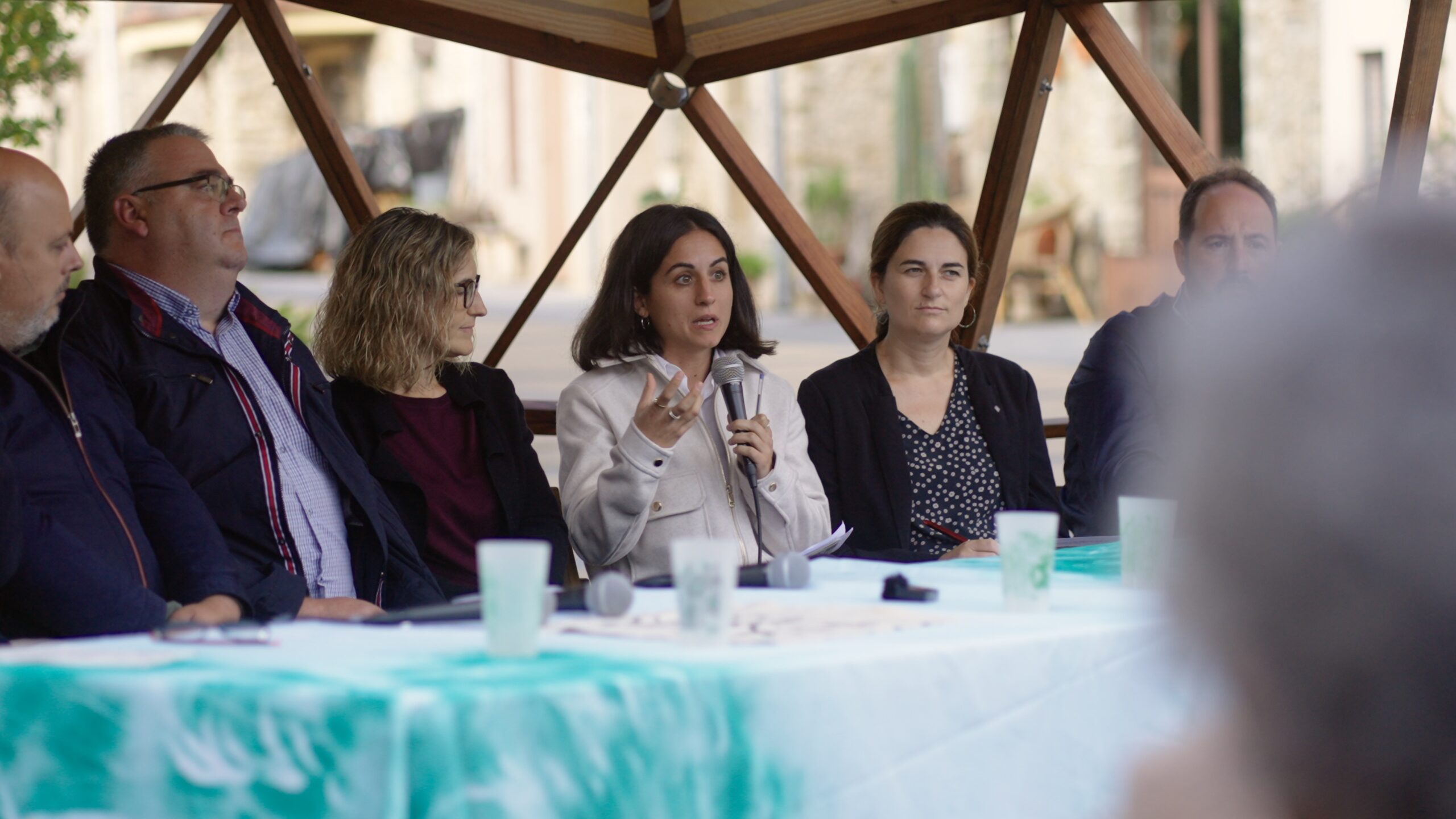Coopératives d'énergie citoyennes: accelerating the energy transition in Luxembourg!
23 min reading
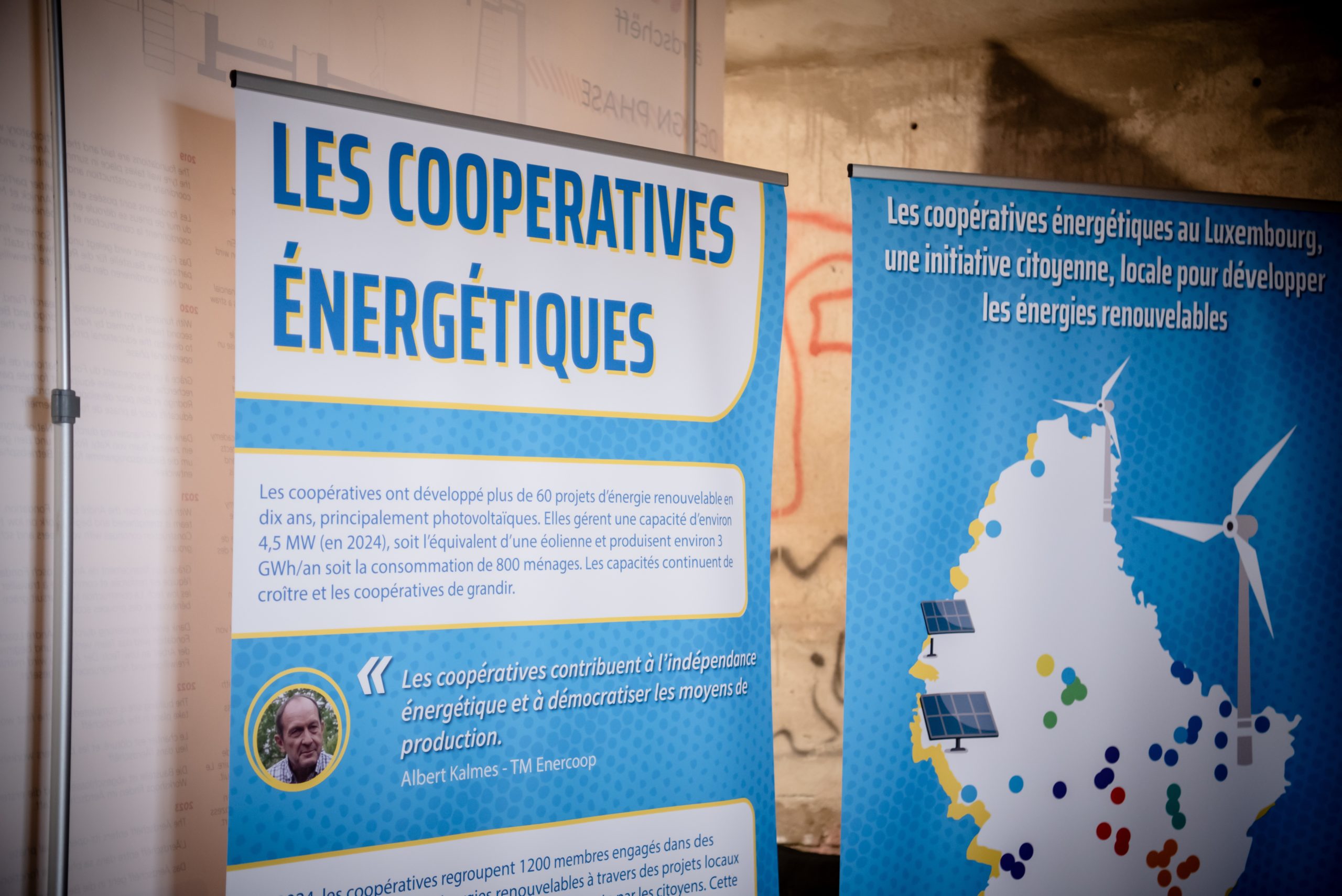
Citizen energy cooperatives in Luxembourg: local, democratic initiatives to promote the energy transition
Growing dynamism of Luxembourg's citizen energy cooperatives, but still limited capacity
From 2012 and the first energy cooperative in Luxembourg, Enercoop, the expansion of this energy production model has been crescendo. Citizen energy had already experienced a revival at the turn of the 2000s among our European neighbors, led by Germany, where 46% of generation capacity was owned by citizens (including farmers) in 2012. This form of production is not new: around 1930, there were 6,000 electricity cooperatives in Germany.. In Luxembourg, this aspect is covered by civil companies. in the first instance, usually on projects involving local communities and residents, then came the cooperatives.
The main difference in status between the two is that cooperatives have a variable capital and members can join at any time which is ideal for a company whose vocation is to develop several projects over the years and to gather news-water cooperators. Note that there are also farmer-owned energy production cooperatives that do not fall into the citizen energy category.
The twelve citizen energy cooperatives in the country today represent some 1,200 members who have invested in over sixty clean energy projects. The vast majority are photovoltaic projects with a number of equity investments in wind projects. This represents around 4.5 MW of installed photovoltaic capacity, which is comparable to the output of an onshore wind turbine.
Cooperative facilities :
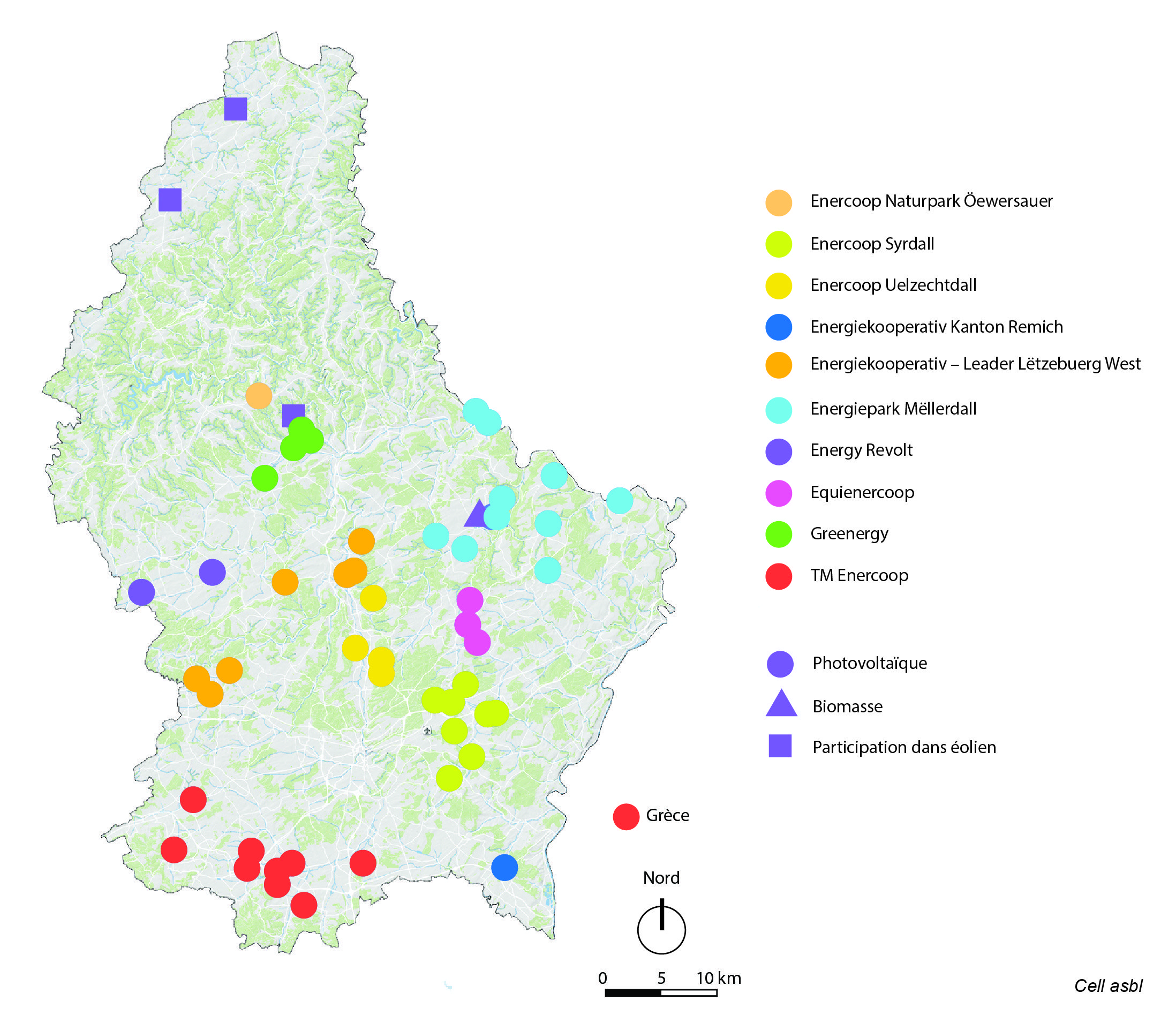
The production capacity of cooperatives is growing steadily, and is now equivalent to the capacity of an onshore wind turbine:
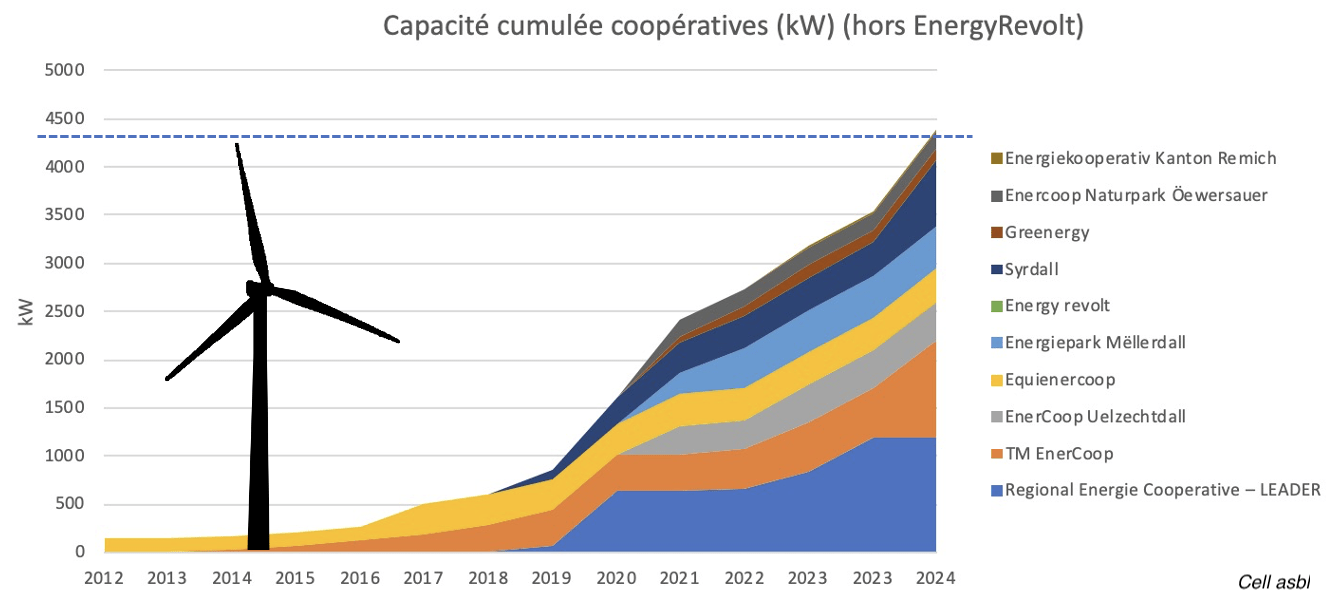
We are witnessing a growing and continuous investment, which nevertheless does not yet allow us to reach a consistent order of magnitude on a national scale. It is estimated that 1% of electricity is produced in Luxembourg by citizen energy cooperatives. There's still a long way to go, despite the relevance of promoting and expanding this citizen-based form of production. The benefits are manifold.
Citizen energy cooperatives: multidimensional assets
Economic dimension The reserve of public savings available for investment in the energy transition is estimated at 240 billion euros by 2030 in Europe [1] . The latest report from the IEA (International Energy Agency) on investment in renewable energies shows an increase in household investment in renewable energies. energy investments from 9% in 2015 to 18% in 2023 [2] . In this sense, the European directive promoting self-consumption and energy communities aims to encourage citizens to become producers of energy and consume it directly, either individually or as part of a community [3] (see box below). Depending on the market price, the electricity produced can be used to generate savings for cooperative members, either through self-consumption or through an affiliated energy distributor. The cooperative South wind in the province of Luxembourg (Belgium) attracted many cooperators when electricity prices came under pressure in 2022-2023, as it enabled them to make substantial savings by contracting with a cooperative distributor. Cooperatives offer a return to their members (between 1 and 5%), even if this lucrative aspect is not the cooperative's raison d'être. A final advantage concerns the local economic spin-offs generated by citizen investment in Luxembourg.
Political dimension The fact that energy projects are carried out by a citizens' group can make them more socially acceptable, particularly in the case of wind power, which can be divisive for local residents. The majority of cooperative projects in Luxembourg concern solar energy, and this aspect doesn't seem to have been a factor so far, but could be in the future. More widely, cooperatives help people take ownership of the means and challenges of energy productiona democratic and transparent guarantor of this essential resource.
Social dimension Luxembourg's existing citizen energy cooperatives all subscribe to the cooperative values of the ILO (International Labour Organization), which include the solidarityThis is expressed through the principle of one vote per cooperator, regardless of the difference in capital he or she has invested. Through cooperatives, tenants also have the opportunity to invest in the transition. A mission of awareness of the public is enshrined in most cooperative bylaws. Finally, we note that cooperative projects are established in all municipalities, regardless of their median income.
Organizational dimension cooperatives have developed expertise in implementing project through full or part-volunteer management. This expertise can enable the development of photovoltaic capacity on municipal roofs, relieving the municipality of this management task. Cooperatives are therefore a key player in stimulating the development of energy projects.
Environmental dimension Finally, the environmental dimension, through the decarbonization of the energy mix made possible by these clean energies (no CO2 emissions), is one of the three pillars of the energy transition, alongside energy efficiency and sobriety (IPCC, Négawatt).
Sidebar: What's the difference between a cooperative and an energy community?
You may have heard of energy communities recently, which are a different concept from the cooperative - but still compatible. Cooperatives are companies with variable capital. which lends itself to the production of community energy, but also to other activities (Raiffeisen, Vin Moselle and Luxlait are cooperatives). The energy community is a principle of energy sharing in the form of a "collective of energy consumers and/or producers, legally organized as a single entity". [4]. A legal status (association, cooperative, etc.) is required to organize the sharing of energy produced by this group of consumers. Find out more on the Klima Agency.
This recently promoted model follows the European directive promoting self-consumption and energy communities. Its aim is to encourage citizens to become energy producers and consumers. Depending on the physical distance of the members of your energy community, you may or may not pay grid usage charges. In the event of rising electricity market prices and energy supply tensions, as has been the case in recent years, self-consumed energy is not tied to this market price, and can generate substantial savings for households.
Cooperative financing enabling everyone to invest in the energy transition
You become a cooperator by purchasing when launching a new project one or more shares in the cooperative (between 50 and 500 euros, depending on the cooperative). This gives the right to vote at the Annual General Meeting, access to remuneration through the distribution of dividends, and the opportunity to play a more active role as a member of the Executive Committee. The executive committee, comprising up to ten people, is responsible for the development and management of the cooperative.
Cooperative financing schemes :
Financing scheme 1 is the simplest. Other, more complex schemes are available, involving banks (scheme 2) or loans to cooperative members. They respond to the particularities and opportunities of each cooperative.
Schema 1:
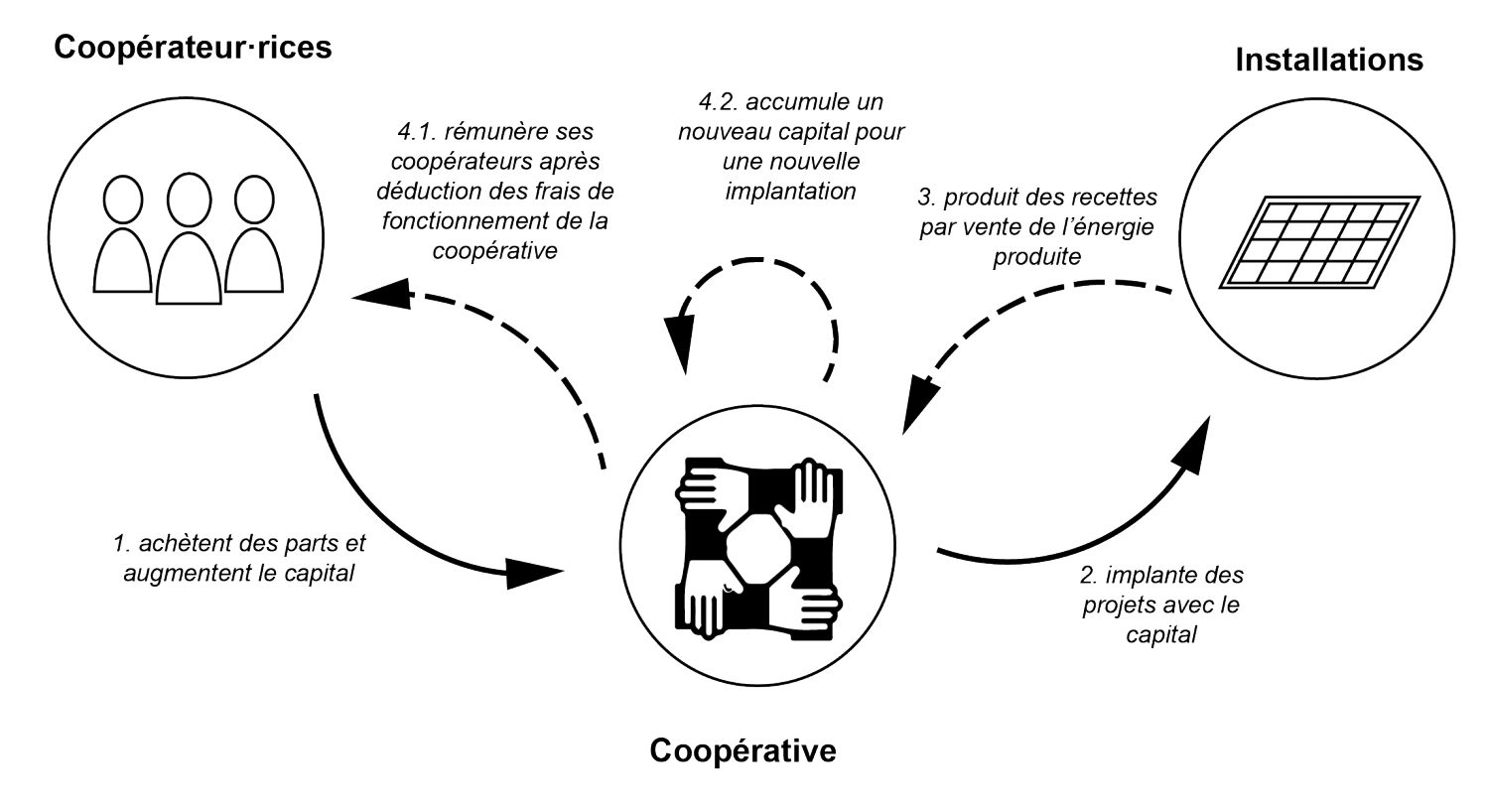
Schema 2:
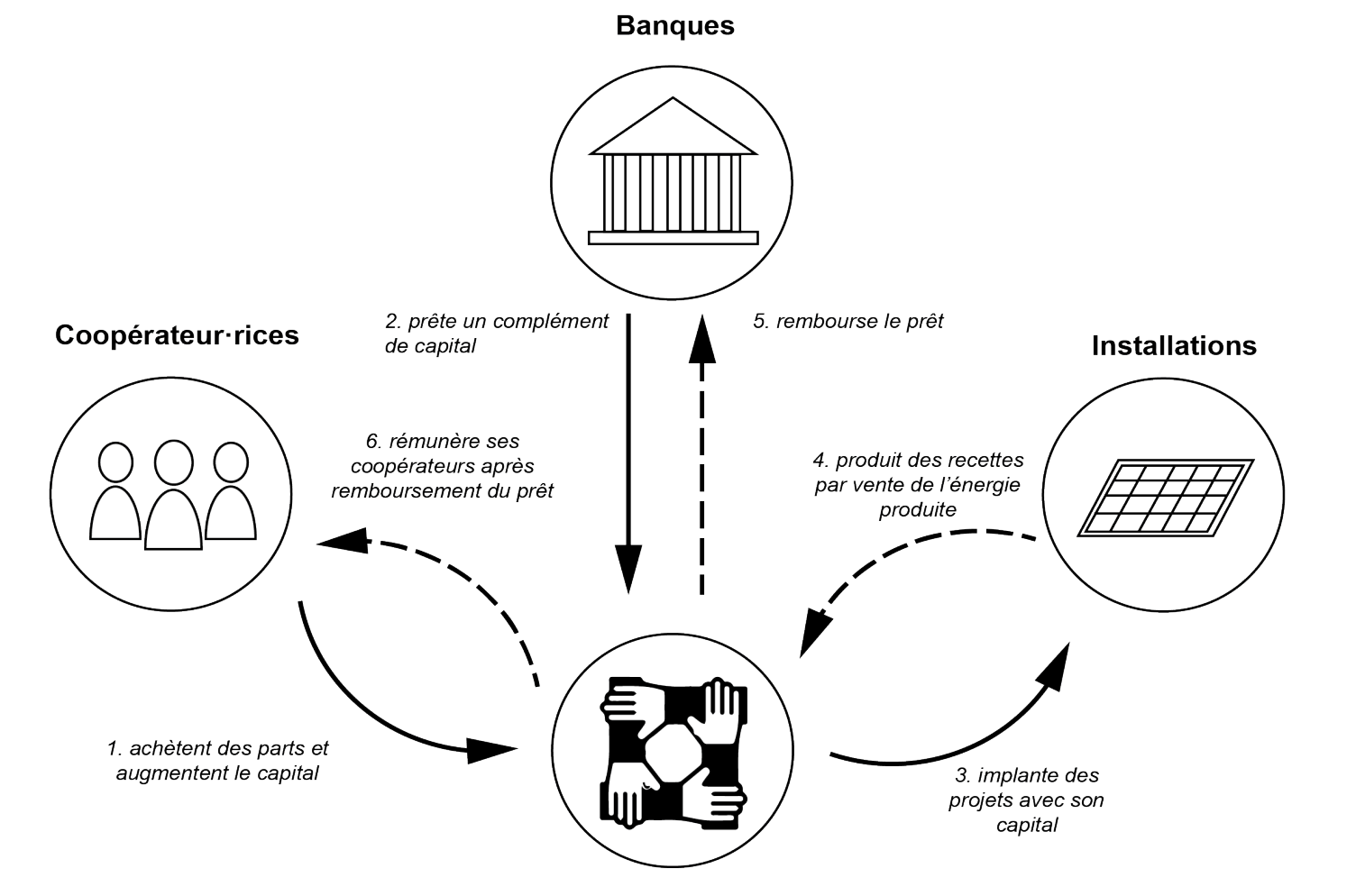
Challenges and issues facing energy cooperatives
The challenge of the subsidy mechanism Cooperatives face a number of challenges. Firstly, the feed-in tariff (FIT) financing model used by the majority of cooperatives has a negative impact on their operations. principle of degressivity (the feed-in tariff decreases every year), which is now causing tension. The government's scheme ensures that the electricity produced is bought back at a fixed rate over a fifteen-year period, providing the stability and visibility essential for public investment. The spirit of the regulation was to take into account the degressive cost of equipment [5]. The cost of equipment has indeed fallen, but at the same time, the rising costs of installation companies have prevented a significant overall reduction in the cost of photovoltaic installations. Today, the feed-in tariff is between €0.1182 and €0.1019 / kWh, depending on the size of the installation, which is barely viable for some of the projects, with cooperatives facing higher costs than private individuals (trustee costs in particular), even if the feed-in tariff is boosted by around +10% for cooperatives. And yet, we know that the support mechanisms in place enable the development of private renewable energy projects. The Chambre des Métiers noted the correlation between the collapse of the market for installations over 30kWp and the withdrawal of their subsidies in 2013.
Injection tariffs for cooperatives based on plant capacity :
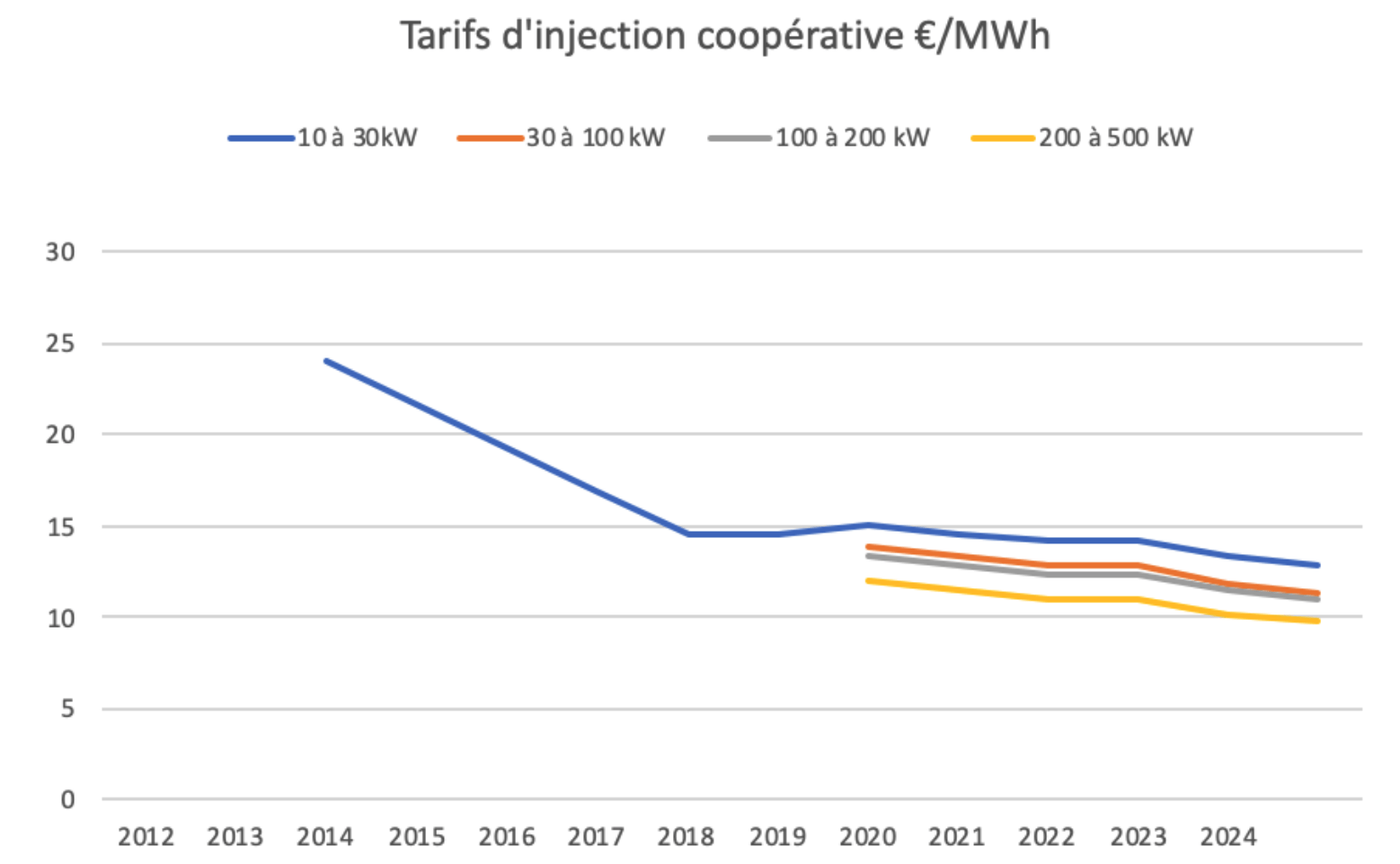
Cost of a few cooperative installations per €/KW installed: the worldwide decline in equipment costs has had little impact on total installation costs in recent years:
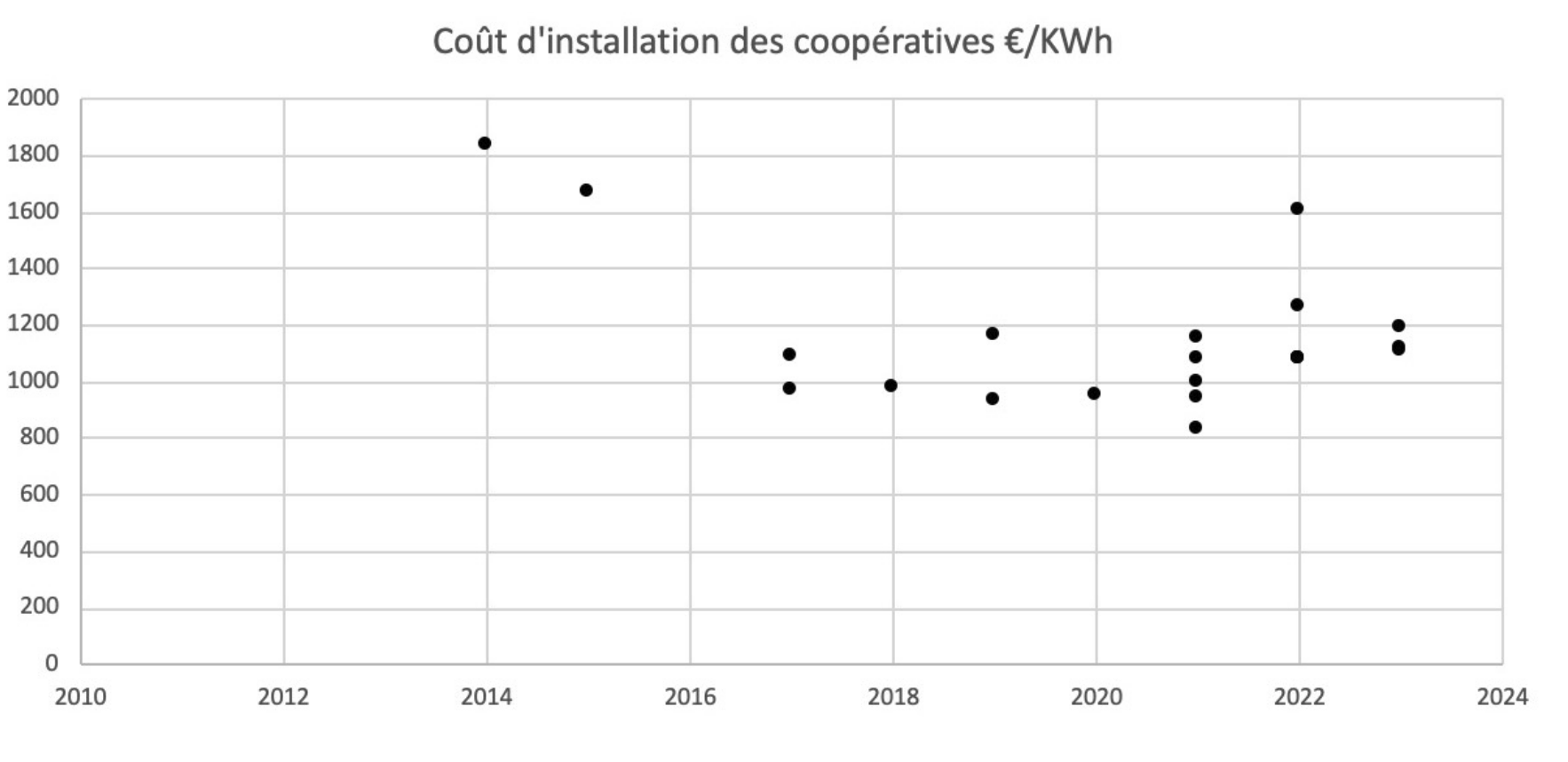
The mechanism is also supported by a compensation fund, partly financed by all energy consumers and partly subsidized by the government [6] . For the latter, this represents a claim on the fifteen-year feed-in tariff. The self-consumption model, which avoids the feed-in tariff, therefore disengages the state financially (even if it continues subsidy programs to finance the installation as such), while complying with the European directive. It therefore seems to be an option that will be favored by legislators. It may also be relevant as an alternative financing model for cooperatives, offering stability with a contractually fixed price, an attractive return and an electricity tariff protected from market volatility for consumers. The first projects under this scheme are currently underway in Luxembourg.
The challenge of roof access The cooperatives also benefit from the support of local authorities, who make roofs available at a low symbolic cost (school roofs, gymnasiums, technical workshops, etc.). This grant-in-kind is not always accessible. In fact, the stock of roofs to be equipped is dwindling, or is in competition with private players or even the municipalities themselves. A second challenge is therefore to gain access to public or private roofs while remaining economically viable. Several options are envisaged: state-owned roofs or, for example, partnerships with private players in the form of provision or self-consumption (the private player makes its roof available to the cooperative, which invests in a photovoltaic installation whose output is sold back to the private player). The development of these new schemes may therefore enable cooperatives to extend their field of action and installation opportunities.
The challenge of access to capital : Since 2012, cooperatives have had no difficulty in raising savings, with citizens welcoming these projects for ecological, economic or local reasons. The rise in interest rates over the past two years has had a dual effect: on the one hand, it has made it more attractive for people to invest in cooperatives.encourage savers to adopt more conservative investment positionson the one hand, benefiting from higher interest rates on passbook savings accounts, and higher cost of capital on outstanding cooperative loans. There is therefore a risk of lower, more expensive capital. Some cooperatives are adapting and, for example, offering loans to their own cooperators at controlled interest rates, which also remunerate cooperative members, reinforcing the appeal of the cooperative model of citizen energy.
TM-Enercoop installation on a local school - Esch-sur-Alzette - 130 kWp in total

The challenge of engaging volunteer members A fourth challenge concerns the volunteer dynamic in cooperatives, which is essential to their civic-mindedness and dynamism. Executive committees are in charge of project development and management, which represents a considerable amount of time. It's a ideal learning opportunity for residents from management and project set-up to the financial and technical aspects of a renewable energy project. The learning-by-doing approach is proving its worth, aided by the spirit of cooperation and mutual aid between the cooperatives. The committees also include a number of experts in engineering and business management, who contribute to the transfer of skills. The cooperative is therefore also a human adventure conducive to personal fulfillment and enrichment. The challenge then is to maintain or develop this civic aspect within the cooperative, particularly when it has been initiated by the community and therefore calls for civic roots.
The need for a favorable institutional and funding framework, which remains to be improved despite broad support from the Luxembourg political spectrum and European directives.
To meet these challenges, the cooperative model of energy production needs a favorable institutional framework. This has a structuring impact on the development of citizen-based renewable energies [7] . In many of the countries studied, the abolition of support policies has led to a decline in citizen projects (or at least a slowdown) [8]. Denmark, for example, had 900 energy cooperatives and lost 88% as a result of weakened institutional support. We also saw above the negative effect in Luxembourg of the removal of certain subsidies in 2013 [9]. The upward momentum must therefore be supported by a favourable incentive frameworkto support the energy transition through public savings. Without this, Luxembourg would be depriving itself of a high-potential lever, mortgaging opportunities for low-carbon energy. Energy that would contribute to the country's resource sovereignty, with local economic spin-offs, a more controlled energy price and the opportunity for everyone to invest in the transition.. Here are just a few examples: guaranteed feed-in tariffs, provision of state-owned roofs, opening up a share of wind power projects to citizens (as has been decided in Wallonia), grid operators assuming the costs of grid connection, accelerated grid connection times, or the development of a national citizen energy strategy. For a more exhaustive list of possible measures, see the work of Rescoop (European Federation of Citizen Energy Cooperatives) [10].
Good newssupport for citizen energy, which can take the form of a cooperative, is the focus of thethe subject of a fairly broad consensus within Luxembourg's political class. This can be seen both in the parties' national political programs (see appendix) and on the ground, at the municipal level, where projects are implemented regardless of the political colors dominant in the municipalities (see figure below).
Results of 2017 municipal elections according to projects implemented by energy cooperatives between 2017 and 2023 (dotted line refers to national results).
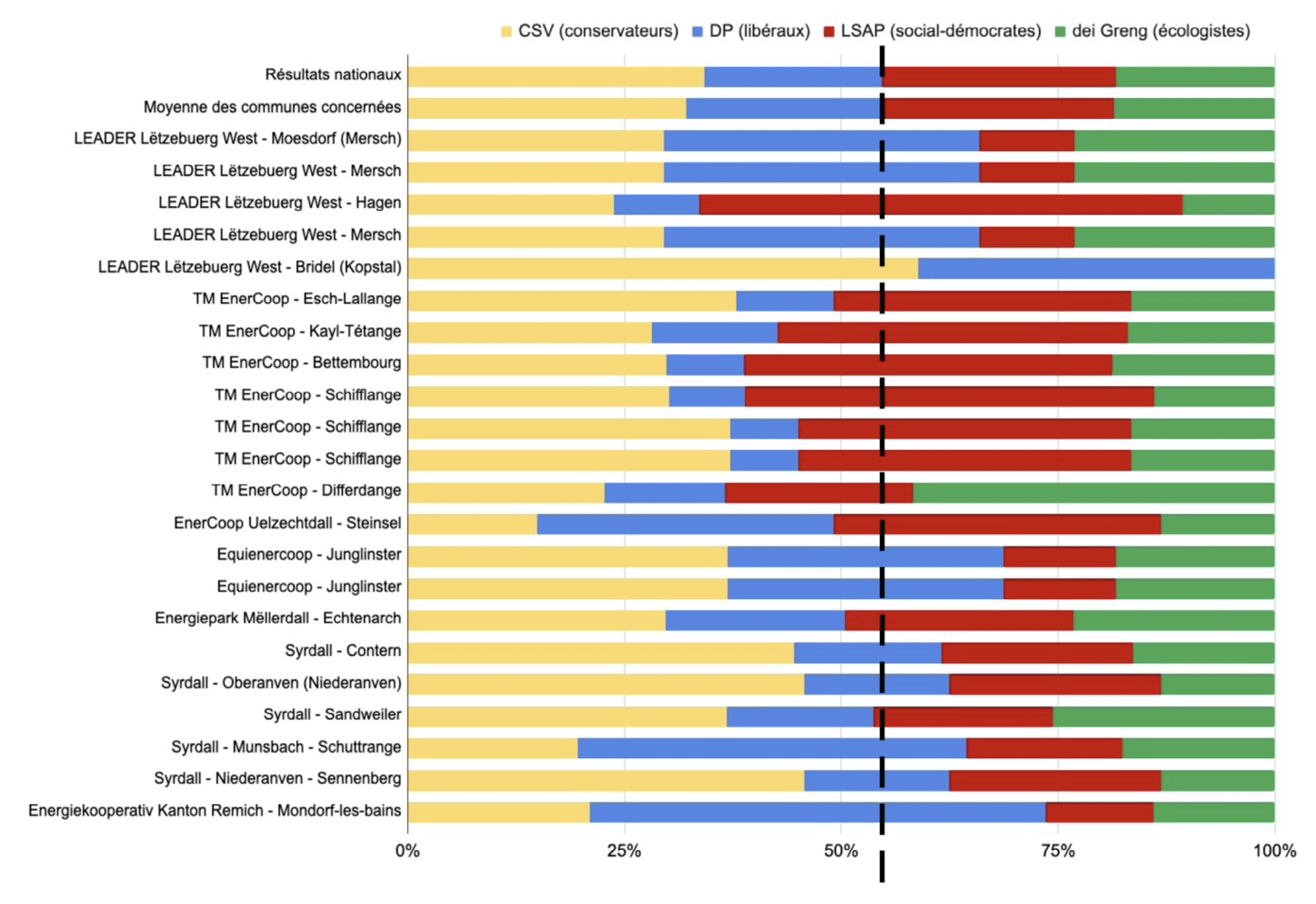
The current coalition agreement also pledges to support energy cooperatives: "The Government will support the operation of photovoltaic installations by cooperatives through appropriate advice and assistance." Nevertheless, the barometer developed by Rescoop(European Federation of Energy Communities) reports that Luxembourg has only partially transposed European directives. on renewable energy communities and citizen energy communities, of which cooperatives are a frequent form [11]. While the barometer for Recovery & Resilience Facility allocation indicates that Luxembourg has not taken energy communities into account [12]. The same applies to the Cohesion Fund. In its latest recommendation for accelerating the development of renewable energies, the European Commission again stressed the need for member states to stimulate citizen energy projects, particularly for medium- and low-income households. There are still improvements to be made and tools to be used.
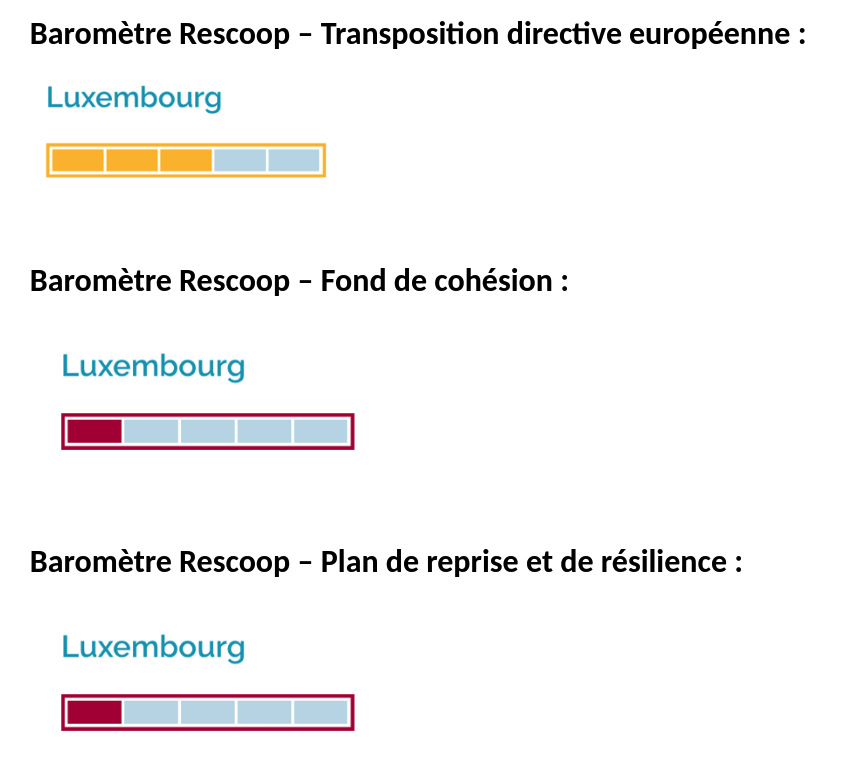
In conclusion
To conclude, citizen energy cooperatives are gaining momentumThey provide concrete answers to ecological and social challenges. Their desire to grow means adapting to new challenges currentThis will require the support of the legal and financial framework, without which it will not be possible to meet the challenges of the future. This will not happen without support for the legal and financing framework, without which Luxembourg would be depriving itself of an opportunity to combine ecology, economy, sovereignty, social justice, citizen participation and resilience.
Want to find out more? Want to get started?
- Discover the cooperative portraits on bibe.cell.lu by selecting "Climate and energy" projects - Consult the interactive map of cooperatives and their facilities here: Eurosolar interactive map
- Three interviews with cooperative players:
- Abbes Kalmes - President of TMEnercoop : youtube.com/watch?v=hf-KcuUWekY
- Michèle Biel - Energiekooperativ Kanton Grevenmacher : youtube.com/watch?v=U8RufF1x06g
- Olivier Martin - Energiepark : youtube.com/watch?v=jJldAi-nsBQ
- Watch the film Eng Äerd (engaerd.lu) where the TM Enercoop cooperative (Esch-sur-Alzette) is presented - to become a cooperator, contact your nearest local cooperative or ask about the launch of a new cooperative installation.
Sources:
[1] https://www.rescoop.eu/uploads/rescoop/downloads/REScoop.eu-manifesto_final.pdf
[2] Energy production, but also electric cars, building renovation, etc. https://www.iea.org/reports/world-energy-investment-2024/overview-and-key-findings
[3] "Member States should stimulate the participation of citizens, including from low- and middle-income households, and energy communities in the planning, development, deployment and operation of renewable energy projects and the related infrastructure projects, as well as take measures to encourage passing the benefits of the energy transition on to local communities, including through participation in energy communities or other co-ownership structures." -Commission Recommendation (EU) 2024/1343 of 13 May 2024 on speeding up permit-granting procedures for renewable energy and related infrastructure projects
[4] https://www.creos-net.lu/particuliers/electricite/autoconsommation-communautes-denergie/communautes-denergie.html
[5] The degressivitý had two in its presentation in 2008: " on the one hand, to encourage potential investors to carry out their projects as soon as the new regulation comes into force and, on the other, to follow the concept advocated in certain areas by the European Commission, which favors this logic to take account of the degressive nature of specific investment costs (in €/kW) in the field of renewable technologies". GOVERNMENT OF THE GRAND DUCHY OF LUXEMBOURG, Draft Grand-Ducal regulation on electricity production based on renewable energy sources, 2008 – linkhttps://www.klima-agence.lu/fr/programmes-aides
[6] Latest report on the clearing mechanism - https://assets.ilr.lu/energie/Documents/ILRLU-1685561960-1153.pdf
[8] Wierling August, Valeria Jana Schwanitz, Jan Pedro Zeiß, Celine Bout, Chiara Candelise, Winston Gilcrease and Jay Sterling Gregg, Statistical Evidence on the Role of Energy Cooperatives for the Energy Transition in European Countries, 2018
[9] Opinion of the Chambre des Métiers of 21.1.2016 - https://wdocs-pub.chd.lu/docs/exped/164/598/156937.pdf
[10] Policy Database: Collection of Public Policies for Energy Communities : https://zenodo.org/records/7301846
[11] "Luxemburg has only proposed the transposition of the REC definition into national law. In doing so, some of the EU criteria have been left out (openness and autonomy). Furthermore, geographical proximity has been defined in an overly-narrow scope, neglecting technical characteristics of different types of activities. The definition leaves legal form open, so that any legal form could become an energy community. Nevertheless, the regulatory authority has a duty to oversee registration aspects of RECs, and service providers are forbidden from becoming a member/shareholder in a REC." - Rescoop Transposition tracker
[12] "Luxembourg's National Recovery and Resilience Plan consists of 12 investment streams and 8 reforms, with a total budget of 88.4 million euros (all in grants). There is no mention of energy communities in the Plan." - Rescoop - Recovery & Resilience Funds
Appendix :
Support for cooperatives and citizen energy in party platforms:
ADR : No specific mentions.
CSV : Political program for the 2023 legislative elections:
- "We are in favor of the extension of solar panels whether on the commune's public buildings, whether on the sole initiative of the communal administration or with the participation of citizens."
- "For new housing developments, we want to offer new concepts in energy production and consumption (prosumer principle)."
Déi Greng: Political program for the 2023 legislative elections:
- Promote new forms of citizen energy initiatives, in the sense of democratizing energy supply. As a national coordination center, the Climate Agency ("Klima-Agency") is to provide the necessary support and guidance for the planning and implementation of energy communities and cooperatives;"
- "Ensure that citizens and municipalities have more options to participate financially in wind and large-scale ground-mounted solar projects;"
- Continue to provide financial incentives for the installation, use and storage of renewable energies. Households and businesses must be encouraged to consume and store the electricity they produce themselves;"
Déi Lénk: Political program for the 2023 legislative elections:
- Social equity and citizen participation will have to play a major role in defining measures. When it comes to renewable energies, we opt for collective, local solutions. For us, communes, villages and neighborhoods should become the places for energy transition, with the implementation of energy production and storage infrastructures within a communal and/or cooperative framework."
- However, the current legislative framework will have to evolve (at national and municipal levels) to facilitate access to this type of collective project (connection costs, technical support, access to wind cadastres, attractive guaranteed price system for non-commercial producers, etc.)".
DP : Political program for the 2023 legislative elections:
- "In principle, we support the creation of partnerships with local and regional energy cooperatives that can advance the energy transition."
- "Luxembourg still has considerable growth potential when it comes to developing wind power. (...) The DP will offer citizens the opportunity to provide financial support for wind turbine projects, with a view to ensuring that the benefits likely to be derived also accrue to them."
Political program for the 2024 European elections:
- Encourage energy cooperatives: especially for citizens who are unable to install PV systems themselves, the formation of energy cooperatives is an interesting way of benefiting from the advantages of the energy transition. The PD will provide citizens with detailed information on this opportunity, and will act as an advisory and support function for those interested."
- Despite high ambitions, the country's renewable energy production capacity is limited. In the future, Luxembourg will not be self-sufficient in energy either, but will depend on extensive energy cooperation with our European partners. It is therefore essential, not least for our security of supply, that Luxembourg takes part in joint projects, such as large-scale offshore wind farms. That's why the government presided over by the DP ensured that Luxembourg was the only country without a coastline to take part in the North Sea Summit, which aims to develop wind energy in the North Sea on a massive scale.
Whether it's offshore wind farms, photovoltaic installations in Southern Europe or climate-neutral hydrogen production, DP will continue to invest in renewable energy projects abroad."
LSAP : No specific mentions.
Piraten : No specific mentions.
85050 vues
0 comments








